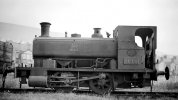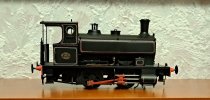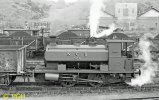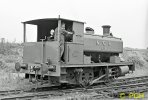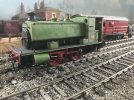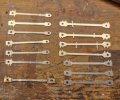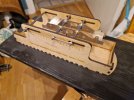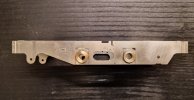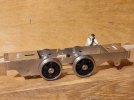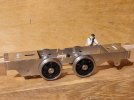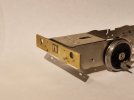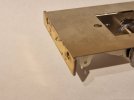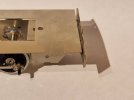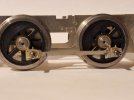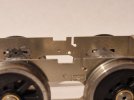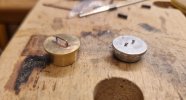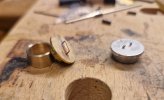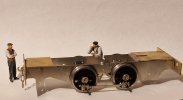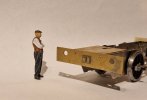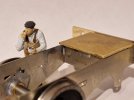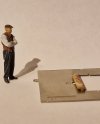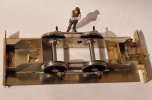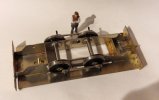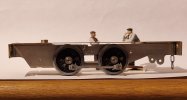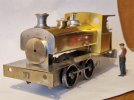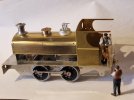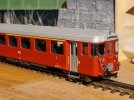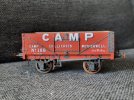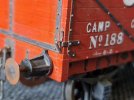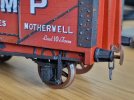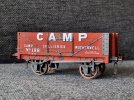I've always had a soft spot for the humble Barclay 0-4-0ST. I'm (just) too young to remember steam on the British mainline, but have happy memories of watching industrial steam on SE Scotland and NE England as well as on many fledgling preservation schemes.
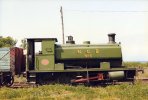
No.6 at Prestongrange in East Lothian awaiting its moment
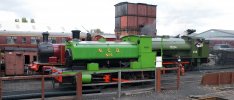
Restored and in use at Bo'ness.
I've long wanted to build one and a couple of years ago bought the Mercian Models kit for the 14" version before Trevor's sad passing.
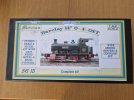
This is for an earlier version than No.6 above, but I will not be building it to any specific prototype. This will be a slow build as it is not my primary focus at the moment but, as I finally put solder to metal last night, I thought I'd start this thread to document the build.
First impressions are good. Nice clean etches, lots of nickle silver! Quite a few options catered for with no less than 3 cabs (with or without backsheet), 2 funnels, backheads, smokebox doors buffers etc. Then I started to dig in a little more detail ...
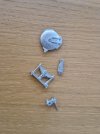
The kit is definitely showing its age with many of the castings quite flashy, most cleaned up OK but a few were a bit too deformed or dented for my taste. Others looked like they had just been brought in from other kits and were not right for a Barclay. The backhead is a work of fiction and the sand boxes are more conical than rectangular. First target, the smokebox.
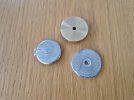
The smokebox protrudes a little from the front of the saddle tank and this is represented with a cast whitemetal disk. Not bad but had a bit of a divot out of it and was not quite as sharp as I would have liked. Also an easy fix with the lathe so I spun up a new one in brass, adding a peg to the back for a more positive location on the tank front.
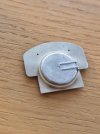
Now soldered to the tank front, I'll epoxy the door on when I've finished soldering brass and nickle silver.
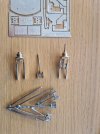
The crossheads are a bit of a puzzle. Three options are provided, two cast and one etched. I can't for the life of me work out how the etched version is supposed to work, there appears to be a front (No. 66, above) but no center or rear. How do they stay in place?! Of the cast options, one has the piston gland/rear and slide bars as a single brass casting, while the other has these components separate in nickle silver and whitemetal (there are two options for motion bracket and cylinder etches to match the various options) Of the 4 cast crossheads, only 1 has a recess for the connecting rod to sit in, the other 3 are solid!
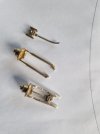
I've opted for the brass casting, although I reserve the option to go for one of the others once I start building up the chassis. The castings were quite distorted and a significant amount of material needed removed to get the crossheads to fit the slidebars. the hole in the piston gland is quite large so I will probably sleeve that and may replace the piston rod with a steel pin which will be rounder, straighter and look more like steel!
This will be a slow-burn project, the kit currently sits in my home-office and provides a pleasant distraction of cleaning up parts when I need a break.
best regards from Stockholm, George!

No.6 at Prestongrange in East Lothian awaiting its moment

Restored and in use at Bo'ness.
I've long wanted to build one and a couple of years ago bought the Mercian Models kit for the 14" version before Trevor's sad passing.

This is for an earlier version than No.6 above, but I will not be building it to any specific prototype. This will be a slow build as it is not my primary focus at the moment but, as I finally put solder to metal last night, I thought I'd start this thread to document the build.
First impressions are good. Nice clean etches, lots of nickle silver! Quite a few options catered for with no less than 3 cabs (with or without backsheet), 2 funnels, backheads, smokebox doors buffers etc. Then I started to dig in a little more detail ...

The kit is definitely showing its age with many of the castings quite flashy, most cleaned up OK but a few were a bit too deformed or dented for my taste. Others looked like they had just been brought in from other kits and were not right for a Barclay. The backhead is a work of fiction and the sand boxes are more conical than rectangular. First target, the smokebox.

The smokebox protrudes a little from the front of the saddle tank and this is represented with a cast whitemetal disk. Not bad but had a bit of a divot out of it and was not quite as sharp as I would have liked. Also an easy fix with the lathe so I spun up a new one in brass, adding a peg to the back for a more positive location on the tank front.

Now soldered to the tank front, I'll epoxy the door on when I've finished soldering brass and nickle silver.

The crossheads are a bit of a puzzle. Three options are provided, two cast and one etched. I can't for the life of me work out how the etched version is supposed to work, there appears to be a front (No. 66, above) but no center or rear. How do they stay in place?! Of the cast options, one has the piston gland/rear and slide bars as a single brass casting, while the other has these components separate in nickle silver and whitemetal (there are two options for motion bracket and cylinder etches to match the various options) Of the 4 cast crossheads, only 1 has a recess for the connecting rod to sit in, the other 3 are solid!

I've opted for the brass casting, although I reserve the option to go for one of the others once I start building up the chassis. The castings were quite distorted and a significant amount of material needed removed to get the crossheads to fit the slidebars. the hole in the piston gland is quite large so I will probably sleeve that and may replace the piston rod with a steel pin which will be rounder, straighter and look more like steel!
This will be a slow-burn project, the kit currently sits in my home-office and provides a pleasant distraction of cleaning up parts when I need a break.
best regards from Stockholm, George!

